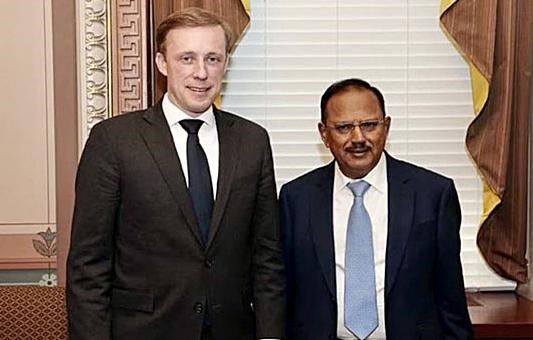Description
 Disclaimer: Copyright infringement not intended.
Disclaimer: Copyright infringement not intended.
Context
- In what is being billed as another important “Quad” in West Asia, Saudi Prince and Prime Minister Mohammad Bin Salman hosted a special meeting of the National Security Advisers (NSAs) of India, the U.S. and the UAE, in the Kingdom of Saudi Arabia.
Highlights of the meeting
- The agenda of the meeting was to consider regional initiatives on infrastructure.
- National Security Advisor’s visit is significant as it follows a week after his visit to Iran, which recently agreed to restart ties in a meeting brokered by Beijing.
- The meeting sought to “advance their shared vision of a more secure and prosperous Middle East region interconnected with India and the world”.
- Many believe that the meetings on infrastructure were meant to provide a counter to China’s Belt and Road Initiative and other inroads in the region, and come months after Beijing brokered a breakthrough in the Saudi-Iran ties.

India and West Asia
- India has economic, political, security and strategic interests with the West Asian countries.
- 70 per cent of India’s imported energy needs come from West Asia.
- India is the largest recipient of foreign remittances from west Asia. 11 million Indians work in West Asia.
Importance
- To counter radicalization
- Gate way to central Asia
- Geostrategic importance
Issues
- Political instability in Syria, Yemen, Iraq
- extra-regional players such as the USA and Russia
- Presence of ISIS and other terrorist groups
- GCC-Iran rivalry
- Shia-Sunni conflict
- Saudi-Iran rivalry
- Arab Israel Conflict
- Israel – Palestine Conflict
- US-Iran conflict.
- Influence of Pakistan
India’s Look West policy
- Cold war period: India remained a passive player though maintained close economic cooperation with both Saudi
- Arabia and Iran.
- India adopted Look West policy in 2005.
- India now follows a Secular and Non- Aligned Policy.
- Focus is on business-to-business and people-to-people relationships.
- There is focus on maritime diplomacy.
- Relationship today is driven more by economic calculation than political rhetoric.

India Saudi Relations
- India and Saudi Arabia enjoy cordial and friendly relations reflecting the centuries old economic and socio-cultural ties.
- The establishment of diplomatic relations in 1947 was followed by high-level visits from both sides.
- The historic visit of King Abdullah to India in 2006 resulted in signing of ‘Delhi Declaration’ imparting a fresh momentum to the bilateral relationship.
- The reciprocal visit by Prime Minister Dr. Manmohan Singh to Saudi Arabia in 2010 raised the level of bilateral engagement to ‘Strategic Partnership’ and the ‘Riyadh Declaration’ signed during the visit captured the spirit of enhanced cooperation in political, economic, security and defence realms.
- India is one of the Kingdom’s 8 Strategic Partner Countries under ‘Vision 2030’.
- Saudi Arabia is India’s 4th largest trade partner and is a major source of energy as India imports around 18 % of our crude oil requirement from the Kingdom.
- In 2018-19, the India-Saudi bilateral trade has increased by 23.83 % to US $ 34.03 billion.
- Saudi Aramco and UAE’s ADNOC are jointly participating in the development of US $ 44 billion ‘West Coast Refinery & Petrochemicals Project Limited’ in Raigad, Maharashtra.
- The 2.6 million (as of August 2019) strong Indian community in Saudi Arabia is the largest expatriate community in the Kingdom and is the ‘most preferred community’ due to their expertise, sense of discipline, law abiding and peace loving nature.
- The Hajj Quota was increased by 24, 975 in 2019, enabling 2, 00, 000 Indians performing Hajj in 2019. Around 7, 00, 000 Indians also visit the Kingdom to perform Umrah every year.
India and UAERelations
- India and United Arab Emirates (UAE) established diplomatic relations in 1972; the UAE Embassy in India was opened in 1972 while Indian Embassy in UAE was opened in 1973.
- India-UAE bilateral relations have received impetus from time-to-time with exchange of high-level visits from both sides.
- India and UAE have following institutional mechanisms in place for addressing sector-specific issues.
- India-UAE commercial relations are anchored by energy cooperation, trade, investments by UAE in India and investments & businesses driven by Indian expatriates in UAE.
- In the energy sector, UAE accounts for 8 percent of India’s oil imports and is the fifth largest supplier of crude oil to India.
- Both the countries have speeded up the relationship to transform from what used to be a buyer-seller relationship into strategic partnership.
- India-UAE trade which was valued at US$ 180 million per annum in the 1970s, is today around US$ 50 billion (exports from India US$ 28 billion and imports to India US$ 22 billion in the year 2017) making India the second largest trading partner of UAE, while UAE is India’s third largest trading partner (after China and US). Moreover, UAE is the second largest export destination of India of over US$ 31 billion for the year 2016-17.
- The two nations share historical ties and have maintained regular cultural exchanges both at official and people to people levels. India and UAE signed a Cultural Agreement in 1975.
- New data from the International Organization of Migration showed that the Indian population in UAE has grown to 3.3 million, making it the largest concentration of Indian nationals outside India. Professionally qualified personnel constitute about 15 & 20 percent of the community, followed by 20 percent white-collar non-professionals.
India and Iran Relations
- India-Iran relations span millennia marked by meaningful interactions.
- The two countries shared a border till 1947 and share several common features in their language, culture and traditions.
- Indian subcontinent and the Persian Gulf have strong commercial, energy, cultural and people-to-people links.
- India and Iran established diplomatic links on March 15, 1950.
- In April 2001 the two countries signed the Tehran Declaration which set forth the areas of possible cooperation between the two countries.
- Both sides signed The New Delhi Declaration in 2003 which set forth the vision of strategic partnership between India and Iran.
- India-Iran bilateral trade during the fiscal year 2018-19 rose to USD 17.03 billion as compared to USD 13.76 billion in 2017-18.
- The value of India’s exports stood at USD 3.5 billion and imports from Iran were USD 13.5 billion.
- During the visit of Prime Minister Shri Narendra Modi to Tehran in May 2016, the contract on Chabahar was signed which, inter-alia, comprises investment of $85 million for equipping the port. The contract also comprises of provision of credit of approximately USD 150 million for the development of the 1st Phase of Shahid Beheshti port at Chabahar.
- The Indian community in Iran comprises of around 4000 Indian nationals.
India-Israel Relationship
- Israel and India established diplomatic relations on 29th of January 1992.
- The two countries have an extensive economic, military, and strategic relationship.
- Political ties between the two countries are friendly.
- Prime Minister Modi undertook an historic first ever visit by an Indian PM to Israel from 4-6 July 2017, during which the relationship was upgraded to a strategic level.
- India is Israel's third largest trade partner in Asia and seventh largest
- Under a comprehensive Work Plan for cooperation in agriculture signed on 10 May 2006, bilateral projects are implemented through Centres of Excellence.
- India is the largest buyer of Israeli military equipment and Israel is the second-largest supplier of military equipment to India after Russia.
- There are approximately 85,000 Jews of Indian-origin in Israel (with at least one Indian parent), who are all Israeli passport holders.

MUST READ ARTICLES:
Quad: https://www.iasgyan.in/daily-current-affairs/quad-2
|
PRACTICE QUESTION
Q) Which of the following statements with reference to India and West Asia Relations is/are correct?
1. India is the largest recipient of foreign remittances from west Asia.
2. 70 per cent of India’s imported energy needs come from West Asia.
- 1 only
- 2 only
- Both 1 and 2
- Neither 1 nor 2
Correct Answer: 3
|
https://epaper.thehindu.com/ccidist-ws/th/th_delhi/issues/35585/OPS/GV3B75G5C.1+GJ4B76ANC.1.html





 Disclaimer: Copyright infringement not intended.
Disclaimer: Copyright infringement not intended.





